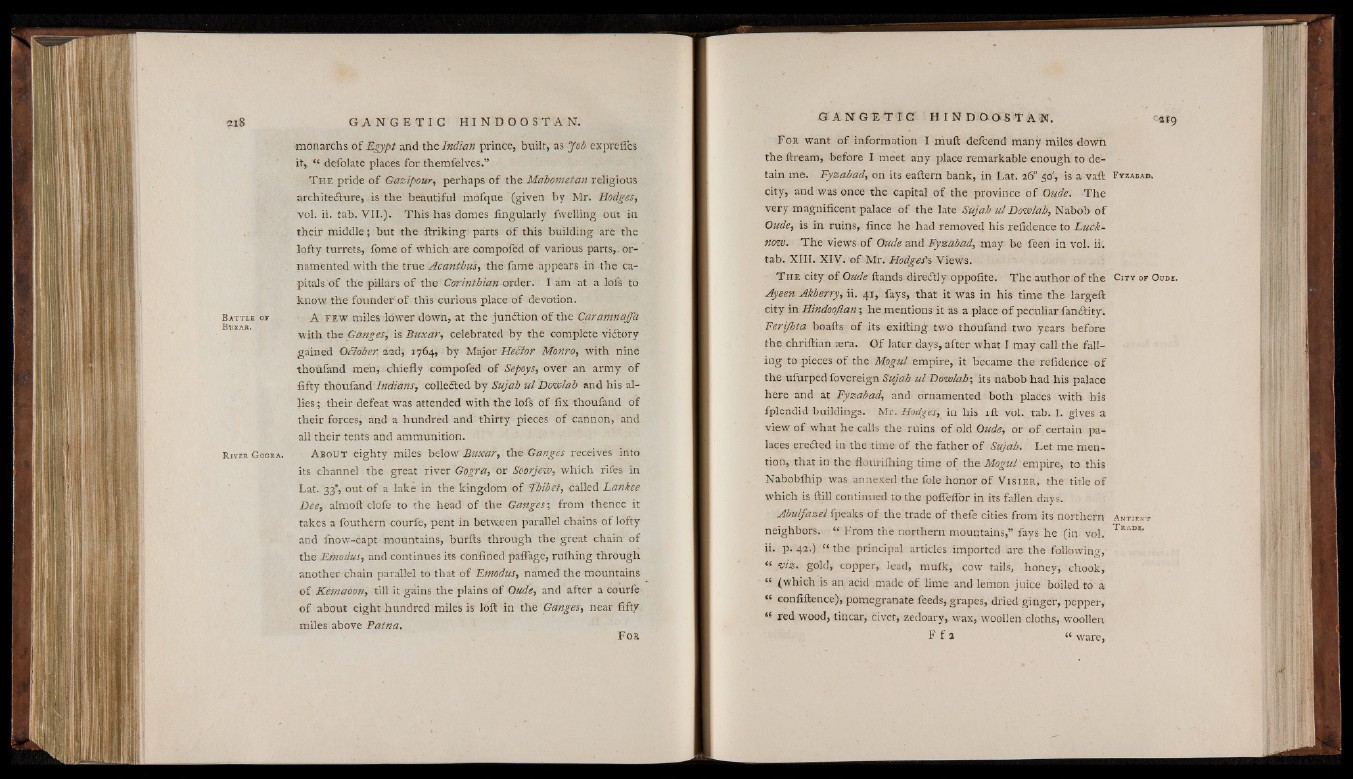
B a t t l e o f
B u x a r .
R iver G ogra.
monarchs o f Egypt and the Indian prince, built, as Job exprefles
it, “ defolate places for themfelves.”
T h e pride o f Gazipour, perhaps o f the Mahometan religious
architecture, is the beautiful mofque (given by Mr. Hodges,
vol. ii. tab. VII.). This has domes Angularly fwelling out in
their middle; but the ftriking parts o f this building are the
lofty turrets, fome o f which are compofed of various parts,, ornamented
with the true Acanthus, the fame appears in the capitals
of the pillars o f the Corinthian order. I am at a lofs to
know the founder of this curious place of devotion.
A f e w miles lower down, at the junction of the CaramnaJJa
with the Ganges, is Buxar, celebrated by the complete victory
gained OElober 22d, 1764, by Major Hector Monro, with nine
thoufand men, chiefly compofed of Sepoys, over an army of
fifty thoufand Indians, colletfted by Sujab ul Dowlah and his allies
; their defeat was attended with the lofs o f fix thoufand of
their forces, and a hundred and thirty pieces o f cafinon, and
all their tents and ammunition.
A b o u t eighty miles below Buxar, Cat Ganges receives into
its channel the great river Gogra, or SoOrjew, which rifes in
Lat. 33’, out of a lake in the kingdom of 'Thibet, called Lankee
Dee, almoft clofe to the head of the Ganges-, from thence it
takes a fouthern courfe, pent in between parallel chains of lofty
and fnow-capt mountains, burfts through the great chain of
the Emodus, and continues its confined pafiage, rulhing through
another chain parallel to that of Emodus, named the mountains
of Kemaoon, till it gains the plains o f Oude, and after a courfe
o f about eight hundred miles is loft in the Ganges, near fifty
miles above Patna.
F o r
F o r want o f information I muft defcend many miles down
the ftream, before I meet any place remarkable enough to detain
me. Fyzabad, on its eaftern bank, in Lat. 26° 50', is a vaft F y -z a e a d .
city, and was once the capital o f the province o f Oude. The
very magnificent palace o f the late Sujab ul Dowlah, Nabob of
Oude, is in ruins, fince he had removed his refidence to Lucknow.
The views of Oude and Fyzabad, may be feen in vol. ii.
tab. XIII. XIV. of Mr. Hodges's, Views.
T h e city of Oude ftands directly oppofite. The author o f the C i t y o f O u d e .
Ayeen Akberry, ii. 41, fays, that it was in his time the largeft
city in Hindoojlan; he mentions it as a place o f peculiar fanitity.
Ferijhta hoafts of its exifting two thoufand two years before
the chriftian sera. Of later days, after what I may call the fall-
ing to pieces of the Mogul empire, it became the refidence of
the ufurpedfovereign Sujab ul Dowlah-, its nabob had his palace
here and at Fyzabad, and ornamented both places with his
fplendid buildings. Mr. Hodges, in his ill: vol. tab. 1. gives a
view of what he calls the ruins of old Oude, or o f certain palaces
erected in the time of the father o f Sujab. Let me mention,
that in the flouriihing time of the Mogul tmpire, to this
Nabobihip was annexed the lole honor of V i s i e r , the title of
which is ftill continued to the pofleflor in its fallen days.
Abulfazel fpeaks o f the trade of thefe cities from its northern Antient
neighbors. “ From the northern mountains,” fays he (in. vol. Tr!' ee-
ii. p. 42.) “ the principal articles imported are the following,’
“ v iz . gold, copper, lead, muik, cow tails, honey, chook,
“ (which is an acid made of lime and lemon juice boiled to a
“ confiftence), pomegranate feeds, grapes, dried ginger, pepper,
“ red wood, tincar, civet, zedoary, wax, woollen cloths, woollen
F f a « ware, .